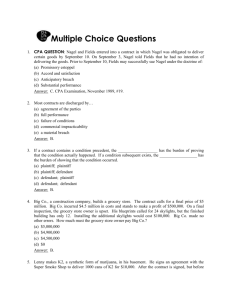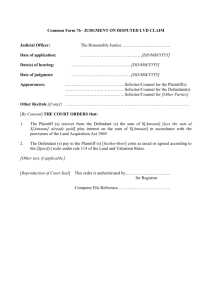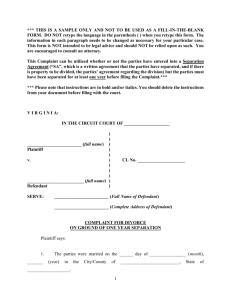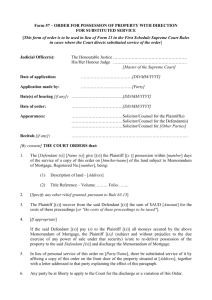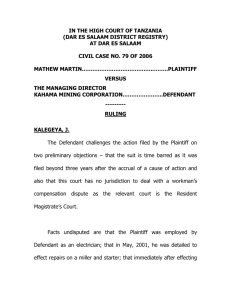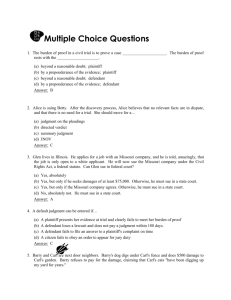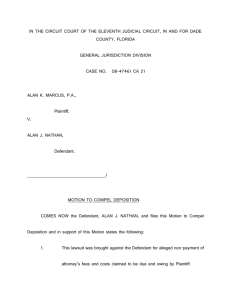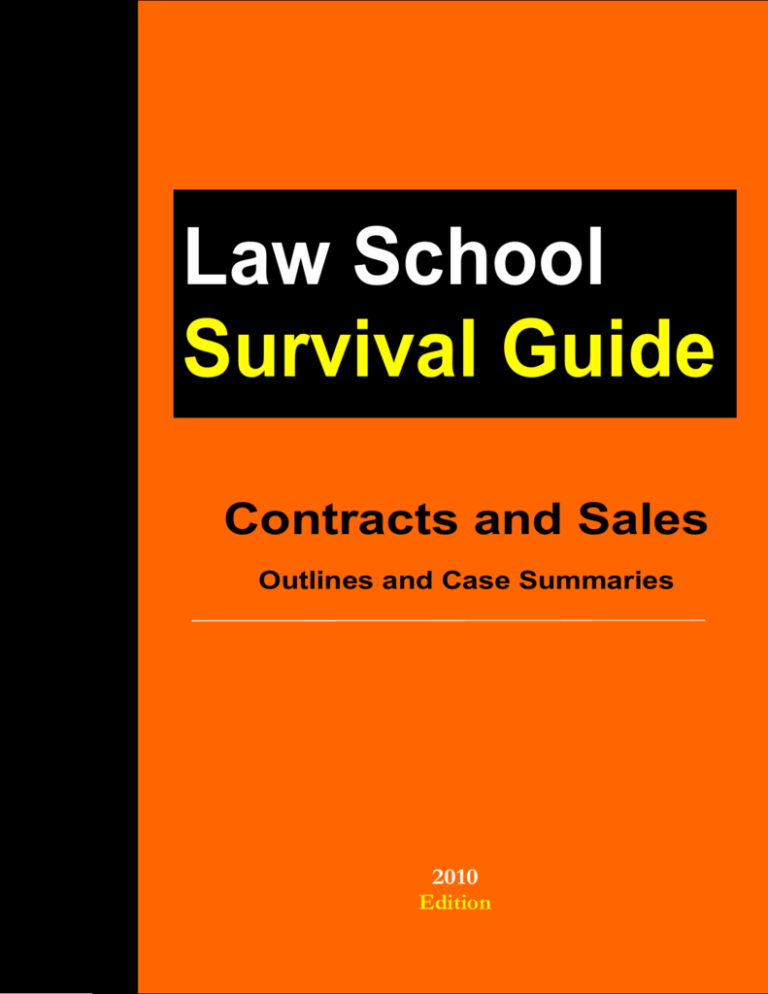
Law School
Survival Guide
Contracts and Sales
Outlines and Case Summaries
2010
Edition
Law School
Survival Guide
Contracts and Sales
Outlines and Case Summaries
COTRACTS AD SALES
Outlines and Case Summaries
Law School Survival Guide
© 2007-10 by Teller Books. All rights reserved. No part of this publication may be reproduced or
transmitted in any form or by any means, including photocopying, recording, or copying to any
storage and retrieval system.
2010 Edition (v.1.3)
Published by Teller Books
Manufactured in the U.S.A.
First printing August, 2008.
DISCLAIMER: Although this book is designed to provide readers with rigorously researched information,
it is not intended to constitute legal advice. Rather, it aims to serve as a general overview of the law that
will help readers to understand basic legal principles and find further information, if necessary. It does not
lay out all of the legal nuances and details that may make the difference in any potential case.
Some judicial decisions discussed in this book, due to their ambiguity, are subject to different
interpretations. Other authors may come to conclusions different from those presented herein. No
representation is therefore made that these materials reflect a definitive statement of the state of the law or
of the views that will be applied by any court in any particular case or jurisdiction.
The law changes with remarkable swiftness as new statutes are passed and innovative judicial decisions are
handed down. The information in this volume could therefore become obsolete with remarkable speed. For
up-to-date legal advice, readers are encouraged to seek the counsel of a qualified attorney or other
professional.
Look for all of these titles in the
TELLER BOOKS
Law School Survival Guides Series
(Outlines and Case Summaries)*:
TORTS
PROPERTY
CIVIL PROCEDURE
COTRACTS AD SALES
COST. CRIMIAL PROCEDURE
BUSIESS ORGAIZATIOS
COSTITUTIOAL LAW
CRIMIAL LAW
FAMILY LAW
EVIDECE
*Available in paperback,
e-book,
Kindle edition,
and iPhone application formats.
TABLE OF COTETS
ABBREVIATIONS ......................................................................................................................................................9
I.
ITRODUCTIO ..............................................................................................................................................11
A.
B.
C.
II.
MUTUAL ASSET ............................................................................................................................................12
A.
B.
C.
D.
III.
INTRODUCTION TO CONDITIONS .................................................................................................................38
SATISFYING A CONDITION ..........................................................................................................................41
EXCUSING CONDITIONS ..............................................................................................................................42
CONSTRUCTIVE CONDITIONS ......................................................................................................................45
WHE THE DUTY TO PERFORM IS DISCHARGED ...............................................................................46
A.
B.
C.
D.
VI.
CONSIDERATION .........................................................................................................................................23
ADEQUACY OF CONSIDERATION .................................................................................................................29
FORMALITIES MANIFESTING AN INTENTION TO BE LEGALLY BOUND .........................................................29
PROMISSORY ESTOPPEL (RESTATEMENT § 90) ...........................................................................................32
THE WRITING REQUIREMENT AND THE STATUTE OF FRAUDS .....................................................................33
CODITIOS AD THE ABSOLUTE DUTY TO PERFORM...................................................................38
A.
B.
C.
D.
V.
THE OBJECTIVE THEORY OF ASSENT ..........................................................................................................12
THE OFFER .................................................................................................................................................13
ACCEPTANCE ..............................................................................................................................................18
E-COMMERCE AND MUTUAL ASSENT .........................................................................................................22
EFORCEABILITY..........................................................................................................................................23
A.
B.
C.
D.
E.
IV.
DEFINING CONTRACTS ...............................................................................................................................11
SOURCES OF THE LAW ON CONTRACTS.......................................................................................................11
CLASSES OF CONTRACTS ............................................................................................................................11
SATISFACTION OF DUTY BY PERFORMANCE ...............................................................................................46
AGREEMENTS DISCHARGING THE DUTY TO PERFORM ................................................................................48
PROSPECTIVE NONPERFORMANCE AND MATERIAL BREACH OF CONTRACT ...............................................49
OTHER WAYS OF DISCHARGING THE DUTY TO PERFORM ...........................................................................51
DEFESES TO COTRACTUAL OBLIGATIO........................................................................................52
A.
B.
C.
D.
LEGAL INCAPACITY ....................................................................................................................................52
OBTAINING ASSENT BY IMPROPER MEANS .................................................................................................53
MISTAKES OF PRESENT EXISTING FACTS ....................................................................................................57
CHANGED CIRCUMSTANCES .......................................................................................................................58
VII. WARRATIES FOR SALES OF GOODS......................................................................................................60
A.
B.
OVERVIEW ..................................................................................................................................................60
REDUCING OR ELIMINATING WARRANTY LIABILITY: BASICS ....................................................................65
VIII. REMEDIES FOR BREACH OF COTRACT ...............................................................................................67
A.
B.
C.
DAMAGES FOR BREACH OF CONTRACT ......................................................................................................67
THREE LIMITATIONS ON DAMAGES ............................................................................................................69
LIQUIDATED DAMAGES V. PENALTY CLAUSES ...........................................................................................73
CONTRACTS AND SALES
D.
OTHER REMEDIES AND CAUSES OF ACTION ............................................................................................... 75
APPEDICES............................................................................................................................................................... 83
TABLE OF CASES ................................................................................................................................................... 85
THEMATIC INDEX.................................................................................................................................................. 87
GLOSSARY ............................................................................................................................................................ 89
8
ABBREVIATIONS
A
AGI
AP
A/R
B
BFP
C
CIF
Cl.
CLEO
Court (cap.)
CP
CR
CSD
CSI
Ct.
Ct. App.
Ct. Chan.
ED
EI
Eng.
ES
FI
FLSA
FMLA
FQJ
FRAP
FRCP
FRCrP
FRE
FS
FSCS
FSD
FS EL
FT
H.L.
IIED
IT
JMOL
JNOV
J/SL
Grantee (for present estate/ future
interest hypotheticals)
Adjusted gross income
Adverse possession
Assumption of the risk
Buyer
Bona fide purchaser or bona fide
purchase
Constitution
Cause-in-fact
Clause
State Chief Law Enforcement
Officer
United States Supreme Court
Court of Pleas (UK)
Contingent remainder
Common Scheme of Development
Compelling state interest
Court
Court of Appeals
Court of Chancery (England)
Emotional distress
Executory interest
England
Equitable Servitude
false imprisonment
Fair Labor Standards Act
Family and Medical Leave Act
Federal question jurisdiction
Federal Rules of Appellate
Procedure
Federal Rules of Civil Procedure
Federal Rules of Criminal
Procedure
Federal Rules of Evidence
Fee simple absolute (fee simple)
Fee simple on condition
subsequent
Fee simple determinable
Fee simple on executory limitation
Fee tail
House of Lords (England)
Intentional infliction of emotional
distress
Intentional tort
Judgment as a matter of law
Judgment non obstante veredicto
Joint and several liability, or
jointly and severally liable
JT
K
K.B.
KSC
L
L1
Lat.
LE
LED
LLC
LLP
LRM
MPC
MSAJ
N
N.B.
NIED
O
OLQ
OO
P
PE
PJ
PJI
PK
Q.B.
R
RAP
RC
Restatement
RFRA
RIL
RPP
Rule
§
S
S.Ct.
SF
SJ
SL
Joint tenant/tenancy
Knowledge (criminal law) or
Contract (all other law)
King’s Bench (UK)
Knowledge to a substantial
certainty
Loss in value
First landlord
Latin
Life estate
Life estate determinable
Limited liability company
Limited liability partnership
Least restrictive means
Model Penal Code
Motion to set aside the judgment
Negligence
Nota bene
Negligent infliction of emotional
distress
Original owner, or grantor (in
present estates and future interests)
Owner of the locus in quo
Original owner
Purpose or purchaser
Privity of Estate
Personal jurisdiction
Pattern Criminal Jury Instruction
Privity of Contract
Queen’s Bench (UK)
Recklessness
Rule against perpetuities
Real Covenant
Restatement (of Contracts, Torts,
Judgments, etc.)
Religious Freedom Restoration
Act of 1993
Res ipsa loquitur
Reasonable prudent person
Federal Rule of Evidence or
Federal Rule of Civil Procedure
Section
Sublessee or seller
Supreme Court or US Supreme
Court Reporter
Statute of Frauds
Summary judgment
Strict liability, or statute of
limitations
CONTRACTS AND SALES
SMJ
SP
T1
TE
TO
UCC
US
10
Subject matter jurisdiction
Specific performance
First tenant
Tenant/tenancy by the entireties
True owner
Uniform Commercial Code
United States of America or
United States Reports
USC
VR
VR SD
(compilation of US Supreme Court
opinions)
United States Code
Vested remainder
Vested remainder subject to
divestment
I.
ITRODUCTIO
A.
DEFIIG COTRACTS
1.
B.
a.
Promise: a manifestation of intention to act or refrain from acting so
made as to justify a promisee in understanding that a commitment
has been made.
b.
Promisor: the party making the promise.
c.
Promisee: the party receiving the promise.
d.
Beneficiary: the party that will benefit from a performance, when
this person is not the promisee.
2.
“A contract is a promise or set of promises, for breach of which the law
gives remedy, the fulfillment of which is a legal duty” (§ 1 Restatement).
3.
“An agreement is a manifestation of mutual assent by two or more persons.
A bargain is an agreement to exchange promises or exchange a promise for
a performance or to exchange performances” (§ 3 Restatement).
4.
A contract can be made orally or in writing, or inferred from conduct (§ 4
Restatement).
SOURCES OF THE LAW O COTRACTS
1.
The case law, which can vary from state to state.
2.
In the sales of goods, the Uniform Commercial Code (UCC).
3.
C.
The Restatement (Second) of Contracts § 2 establishes the following
definitions:
a.
This is a uniform law that that all of the states have adopted.
b.
However, Louisiana has not adopted the UCC in all of the ways
suggested its drafters.
c.
The UCC applies to contracts for the sale of goods (art. 2) and for
leases (art. 2A).
d.
The UCC also deals with negotiable instruments (art. 3), bank
deposits (art. 4), letters of credit (art. 5), investment securities (art.
8).
e.
The present text will limit itself to discussing sales of goods and will
make some mention of the UCC provisions with respecto to leases.
Furthermore, secondary sources such as the Restatement (Second) of
Contracts, legal treatises, and scholarly articles may apply.
CLASSES OF COTRACTS
1.
Bilateral contracts are accepted by return promise.
CONTRACTS AND SALES
a.
2.
II.
Example: a contract in which A promises to sell B land at a
particular price if B promises to purchase the land at that price.
Unilateral contracts are accepted by performance.
a.
Example: A promises to pay $10 to whoever finds and brings him
his lost dog.
b.
The person who finds and brings the dog, without notifying A of his
acceptance or promising to bring A the lost dog, is entitled to the $5
at the time he brings the lost dog.
MUTUAL ASSET
A.
THE OBJECTIVE THEORY OF ASSET
1.
An Objective Meeting of the Minds: the Reasonable Person Standard
a.
For there to be a valid contract, there must be a “meeting of the
minds.”
b.
Actual mutual assent is not required; it is the expression of assent
through behavior that matters.
c.
What is important in the objective theory of assent is not the inner
motives of the parties, but rather, their outward expressions.
d.
Determining the “secrets of the mind” is thus not necessary in
determining mutual assent.
i.
e.
One must determine whether a reasonable person in the offeree’s
position would come to conclude that an offer or assent to an offer is
being made.
f.
Even if the offeror is joking or intoxicated, if his outer conduct
would lead a reasonable person to conclude that there was an
agreement, then the promise is enforceable.
i.
2.
12
See Embry v. Hargadine, McKittrick Dry Goods Co. (Mo. Ct.
App. 1907), where the defendant acted as though the plaintiff had
his job contract back, but then fired him after two months. The
court ruled in favor of the plaintiff, since the defendant expressed
his assent through behavior and whether he intended to renew the
contract was irrelevant.
See Lucy v. Zehmer (Va. 1954), where a court held that if the
defendant were sober enough to spend forty minutes discussing
the terms of an agreement, then regardless of whether he was
intoxicated, that promise was enforceable because of the
manifestation of assent.
A Written Contract
a.
The commitment does not need to be memorialized as a written
contract.
b.
A contract is enforceable as soon as there is a meeting of the minds.
II. MUTUAL ASSENT
i.
B.
See Sanders v. Pottlitzer Fruit Co. (N.Y. I894), where after much
negotiation, the plaintiff sends a letter offering apples, the
defendant says it will take apples only if conditions are met, and
the plaintiff accepts. The defendant then asks for the written
contract to be sent, which it tries to change. The plaintiff refuses to
change it and sues to enforce the original contract. The court held
that an agreement in the prior correspondences; a formally written
contract is not required. Judgment for the plaintiff.
THE OFFER
1.
Definition
a.
2.
An offer is a manifestation of willingness to enter into a bargain, so
made as to justify another person in understanding that his assent to
that bargain is invited and will conclude it (§ 24 Restatement).
The Four Elements of an Offer
a.
A Commitment
i.
There must be a promise to enter into a contract, not an invitation
to negotiate.
ii.
Language such as “I offer” or “I promise” tends to indicate
commitment; language such as “I consider” or “I quote” tends to
indicate an invitation for offers.
iii.
If offeror did not intend to make the offer, the objective test will
be used: “would a reasonable person in the offeree’s position
know or should he have known that there was an offer?”
iv.
To answer this question, the following will be considered:
1)
Industry practices and prior practices between the parties.
2)
Circumstances: was the offer made in jest? If so, would a
reasonable person have construed it to be an offer?
a)
b.
c.
See Zehmer, where the defendant said he was joking
about selling his land, but the court held there was a
commitment because a reasonable person would not
have understood that he was joking.
Communicated
i.
The offeree must have knowledge of the offer before being able to
accept it.
ii.
Example: A offers to buy B’s car for $5,000. B, before he finds
out about the offer, says that he will give A his car for the same
price. Since A’s offer was not communicated to B, B’s
communication is merely another offer; it does not constitution
acceptance.
To an Identified Offeree
i.
An offer is always personal; it cannot be transferred to a third
party.
13
CONTRACTS AND SALES
ii.
The broader the medium for communicating the offer, the more
likely the courts will construe the communication to be an
advertisement.
iii.
Advertisements are not offers, but rather, invitations to negotiate
or make offers.
iv.
1)
See +ebraska Seed Co. v. Harsh (Neb. 1915)152 N.W.
310 (Neb. 1915), where a farmer invited a company to buy
about 1,800 bushels of seeds for $2.25 each, and the
company accepted. When the farmer did not deliver, the
company sued for breach of contract. The court held that
there was never an offer, since the communication was not
made to an identified offeree, but rather, to several.
Furthermore, the delivery time and subject matter (“about”
1800 bushels) was indefinite.
2)
See also Leonard v. Pepsico (S.D.N.Y. 1999), where an
advertisement was held not to be an offer, and
furthermore, tested by the reasonable person standard, the
content of the advertisement was an obvious joke, not a
real offer.
However, the Restatement (Second) of Contracts allows offers to
be made to more than one person (§ 29 Restatement). The
communication would be a valid offer if it can only be construed
as being open to a single offeree.
1)
d.
For example, if a subject offers a reward to whoever finds
and returns his lost dog, a court would treat the
communication as an offer, since it is implicitly being
communicated to an identified offeree: the first and only
person to return the dog.
With Definite Terms
i.
For an offer to be enforced, it must contain definite terms.
ii.
Each category of contracts calls for different terms to be specified.
1)
For contracts of realty, the price and the land to be sold
(the amount and location) must be specified.1
a)
2)
1
The land must be identified as to both the amount
and the location to be sold.
For employment contracts, the duration must be
determined.
a)
The duration may be manifested as a period of time
(e.g., a one year employment contract) or as a task
(e.g., a contract to repair a computer).
b)
If the duration is not specified, the offeree is
considered hired at will and can quit or be fired at
With respect to the description of the land, the test turns on whether a court can identify the land to be sold in order
to enforce the contract.
14
II. MUTUAL ASSENT
anytime without being able to enforce any time
provision.
3)
3.
For contracts for the sale of goods under the UCC, only
the quantity must described (UCC Official Comment 1, §
2-201).
a)
The indicated quantity need not be accurate, but the
contract cannot be enforced beyond this quantity.
b)
Other terms, such as the price, place of delivery, or
time of delivery, can be determined by the UCC
gapfillers.2
c)
There are two exceptions to this rule:
i)
Requirements contracts (e.g., “I will buy as
many units as I need”); and
ii)
Output contracts (e.g., “I will buy as many
units as you produce”).
d)
If terms, such as place of delivery and time of
delivery, are left unspecified, the court can fill these
in with what is reasonable.
e)
If the price is unspecified, the court can fill it in
when: (i) there is no mention of price in the
negotiation; (ii) the price was left to the parties to
agree upon but they did not; or (iii) the price was left
to be determined by the market.
i)
For example, if A offers to sell B ten
widgets “for the price we agree to,” the
price can be determined by the court, since
the price was left to the parties to agree
upon.
ii)
However, if A offers to sell B ten widgets
“for a reasonable price,” a court cannot fill
in the price because the offer does not fit
into one of the three circumstances defined
above.
iii)
Since price is not determined, it is not a
valid offer and the agreement is
unenforceable; the court is not going to try
to determine what a reasonable price is.
Terminating an Offer
a.
The offeree’s power of acceptance is terminated in the following
circumstances (§ 36 Restatement):
i.
The offeree rejects the offer or makes a counteroffer;
ii.
There is a lapse of time (must be reasonable);
2
In the case of an open price term, see § 2-305 UCC; for the absence of a specified place of delivery, see § 2-308
UCC; for the absence of specific time provisions, see §2-309 UCC.
15
CONTRACTS AND SALES
iii.
The offeror directly or indirectly revokes the offer:
1)
The offer is considered to be indirectly revoked if the
offeree receives reliable information that would lead a
reasonable person to conclude that it has been revoked
(e.g., when the offeree learns that the offeror is searching
for other purchasers).
2)
See Dickinson v. Dodds (Ct. App. U.K. 1876), where
Dodds, the defendant, gave the plaintiff an option not
bearing consideration that would remain open for two
days to buy his house for 700 pounds. The plaintiff heard
of Dodd’s intent to sell the land to another purchaser, even
though he never communicated a formal, direct
revocation. The plaintiff then accepted the offer and sued
for specific performance when the land was not delivered.
Held: although Dodd’s revocation was not directly
communicated to the plaintiff, the offer was terminated
the moment that the plaintiff heard about it indirectly.
a)
iv.
b.
c.
16
+.B.: if there had been any consideration on the
option, real or recited, the offer would have been
irrevocable until the agreed-to termination.
The offeror or offeree dies or is incapacitated.
1)
If the offeror dies before the offeree accepts the offer, the
offeree’s power of acceptance is terminated and no
contract is formed.
2)
However, if the offerree accepts just prior to the offeror’s
death, an enforceable contract is formed. Once there is a
meeting of the minds, the death of either party does not
invalidate the contract.
Exception: Options Contracts
i.
If an options contract is supported by consideration (or, in many
courts, by recital thereof), the offeree’s power of acceptance is not
terminated through his rejection of the offer, counteroffer, death or
incapacity, or through the direct or indirect revocation by offeror.
ii.
However, if there is no consideration, an options contract can be
terminated in the same way that a regular offer can be terminated
(rejection, lapse of time, revocation or death or incapacity).
Revocation of Unilateral Contracts
i.
In the case of unilateral contracts, where the offer is accepted by
performance, the offeror may revoke the offer at any time before
the offeree completes performance.
ii.
However, where there is a tender (unconditioned willingness to
perform immediately coupled with a manifest ability to perform)
or a beginning of performance (more than just preparation to
begin performance), a binding option contract is formed that the
offeror is unable to revoke.
PAGE NOT AVAILABLE
The page you have selected is not available in this preview. To
read the book in its entirety, it may be purchased by visiting the
website of TellerBooks at: www.TellerBooks.com.
PAGE NOT AVAILABLE
PAGE NOT AVAILABLE
The page you have selected is not available in this preview. To
read the book in its entirety, it may be purchased by visiting the
website of TellerBooks at: www.TellerBooks.com.
PAGE NOT AVAILABLE
PAGE NOT AVAILABLE
The page you have selected is not available in this preview. To
read the book in its entirety, it may be purchased by visiting the
website of TellerBooks at: www.TellerBooks.com.
PAGE NOT AVAILABLE
VIII. REMEDIES FOR BREACH OF CONTRACT
d.
See Parker v. Twentieth Century-Fox Film Corp.
(Cal. 1970), where the defendant hired the plaintiff
Parker to play lead role in a musical for $750,000.
The defendant breached the contract and instead
offered the plaintiff the chance to play a lead role in
a Western style movie to be filmed in Australia
under similar terms. The plaintiff refused the new
contract and sued for damages. The defendant
argued that accepting the new job was required
mitigation. Held: the plaintiff is not required to
accept the new job as mitigation because the new job
is substantially different from the old and cannot
substitute it. The plaintiff is entitled to the $750,000.
b)
+.B.: the court never discussed the plaintiff’s duty to
make reasonable efforts to find work. It may have
been because these kinds of jobs come around so
rarely that it may not have been practical to have
required her to make such efforts.
Mitigation in the Sale of Goods under the UCC
i.
C.
a)
General rule when the buyer breaches:
1)
If the seller resells the good, he is entitled to the difference
between the purchase price and the contract price.
2)
If the seller does not resell, he is entitled to the difference
between market price and contract price plus incidental
and consequential damages minus costs avoided.
ii.
If the seller withholds delivery because of the buyer’s breach, he
must refund the defendant all the money that the defendant gave
him less either $500 or 20% of contract price, whichever is less.
UCC § 2-718(2).
iii.
However, this rule is subject to another damage-measuring
formula under UCC § 2-708:
1)
Damages for the seller are the difference between the
market price and the contract price at the time and place of
tender, plus incidental and consequential costs, minus
costs saved.
2)
If § 2-708(1) does not offer a reasonable result, then the
seller may collect the profit (including reasonable
overhead) that he would have made, plus incidentals, due
allowance for costs, and due credit for payments.
LIQUIDATED DAMAGES V. PEALTY CLAUSES
1.
Introduction
a.
Generally, damages for breach of contract are equal to expectation
damages, reliance damages or restitution damages.
73
CONTRACTS AND SALES
b.
However, when calculating damages would be too difficult, the
parties may elect to include liquidated (stipulated) damages clauses
in the contract itself, to be applied in case of breach.
c.
However, courts are hesitant in enforcing stipulated damages clauses
that appear to be penalties.
i.
2.
3.
Stipulated damages clauses will generally not be enforced when:
a.
Actual damages can be calculated; and
b.
The stipulated damages are significantly greater than the actual
damages (this indicates that the stipulated damages are really a
penalty).
i.
Courts are especially reluctant to enforce stipulated damages
clauses when they apply to even immaterial breaches.
ii.
See Kemble v. Farren (C.P. 1829), where the defendant Farren had
a contract to be a comedian at the Royal theatre with a 1,000 £
liquidated damages clause. When the defendant breached after the
second season, the plaintiff sued to recover the full 1,000 £. Held:
because this contract allows the plaintiff to collect 1,000 £ in
damages for even slight breach, it functions as a penalty clause
and will not be enforced.
On the other hand, courts will enforce liquidated damage clauses when they
are reasonable, as determined by three factors:
a.
There is no intent to create a penalty clause.
b.
The damages would be difficult for a court to ascertain at the time
the contract was made.
i.
c.
+.B.: under the minority approach, courts look to see if the
damages would be difficult to ascertain at the time the suit is
brought.
The damages accurately predict the damages at the time they arise.
i.
74
Rationale: contracts must be seen in terms of economic realities.
When damages could be calculated, the non-breaching party
should be able to recover only monetary damages. When
exorbitant damages are claimed, they are seen by the courts as
penalties, which the contract law does not recognize.
See Wassenaar v. Towne Hotel (Wis. 1983)., where the plaintiff
employee Wassenaar entered into an employment contract with
the defendant. Under a stipulated damages clause, the defendant
was responsible for its entire three year financial obligation to pay
the plaintiff in the event that the defendant terminated the contract
prematurely. While twenty one months remaining, the defendant
terminated the contract. On the issue of whether the penalty clause
was valid, the court held that the damages for breaching the
employment contract comprised more than just the amount of
money owed; it also included harm to reputation and other
VIII. REMEDIES FOR BREACH OF CONTRACT
incalculable factors. The liquidated damages clause was therefore
applied.
ii.
D.
+.B.: this court did not require the plaintiff to mitigate damages
because when a stipulated damages clause is found to be
reasonable, the non-breaching party is not required to mitigate.
However, although courts do not formally require mitigation, in
practice mitigation is factored into courts’ decision through courts’
analysis of reasonableness of liquidated damages clauses. If in
Wassenaar, the defendant was able to get information into record
that the plaintiff had in fact gotten a job just after leaving the
defendant’s employment, the court, in evaluating the accuracy of
the stipulated damages clause in predicting actual damages, would
have held that this factor was not met. It would have therefore
probably found the clause to be unreasonable, and would not have
honored it. Instead, it would have required the plaintiff to prove
expectation damages. Thus, mitigation may be indirectly factored
into the analysis.
OTHER REMEDIES AD CAUSES OF ACTIO
1.
Specific Performance and Injunctions
a.
b.
General Rule
i.
Specific performance (SP) and injunctions will not be ordered by a
court unless there is no adequate remedy at law (i.e., money
damages).
ii.
It is an exceptional remedy that tends to be applied in only real
estate transactions.
Contracts for Land
i.
For real estate transactions, SP is granted as a matter of course.
1)
ii.
See Loveless v. Diehl (Ark. 1963), where the defendant
leased his farm to the plaintiff Diehl for three years with
an option to purchase it for $21,000. The plaintiff found a
buyer who would buy the land, allowing the plaintiff to
make a $1,000 profit, but when the defendant found out
about this, he repudiated the options contract. The plaintiff
sued for SP. The defendant counterclaimed for a $1,440
promissory note. The courts originally held that the
plaintiff was entitled to $1,000 and the defendant was
entitled to the payment of the promissory note. On
rehearing, it was held that there was no reason to deny SP.
The general rule is that for realty, SP is granted as a matter
of course. The plaintiffs spent much more on improving
the property than the meager $1,000 awarded as damages.
To refuse SP would be to unjustly enrich the sellers for
breaching their own options contract.
But if it can be shown that there really is no difference between
two pieces of real estate, then only damages will be rewarded (this
would be exceptional).
75
CONTRACTS AND SALES
c.
Contracts for Goods
i.
Under the common law, courts only order SP when the goods are
scarce, rare, irreplaceable, or of sentimental value.
1)
ii.
UCC § 2-716 similarly awards SP when the good is unique or in
other proper circumstances (e.g., it is not commercially feasible
for the plaintiff to obtain the good).
1)
d.
See Sedmak v. Charlie’s Chevrolet (Mo. App. 1981),
where the plaintiff ordered a limited edition Corvette from
the defendant for $15,000. When the time came to tender
purchase, the value rose and the defendant reneged on its
promise and required the plaintiff to bid on the car. The
plaintiff sued for SP. Held: although this Corvette is not
unique, it is so rare and finding the equivalent would be so
difficult that under UCC § 2-716(1), judgment for SP is
affirmed.
Contracts for Personal Services
i.
Originally, SP was offered for contracts for personal services.
ii.
However, courts later became unwilling to order SP, finding such
orders impractical and unjust.
1)
iii.
See The Case of Mary Clark, A Woman of Colour (Ind.
1821), where Mary Clark sued to be freed from Johnston,
to whom she voluntarily indentured herself. Johnston
called for SP, arguing that Clark should be bound by a
contract she voluntarily signed. Held: to enforce this
contract and require SP would be to put Clark in a state of
involuntary servitude. She should be discharged.
Just as courts were reluctant to enforce SP, they also were
reluctant to enforce negative injunctions, which prohibit the
breaching party from taking on similar work. Many courts
consider negative injunctions to be an indirect form of SP.
1)
76
See Cumbest v. Harris (Miss. 1978), where the defendant
Harris loaned the plaintiff money and the plaintiff gave
the defendant hi-fi equipment as collateral, with an option
to purchase the equipment at any time before 5 pm on a
specified date. When the day arrived, the plaintiff did
everything he could to purchase the goods, but the
defendant avoided him. The plaintiff sued for SP. The
court held that the test for determining whether SP should
be rewarded requires the court to consider whether
damages are adequate. Here, some parts of the equipment
were irreplaceable and other parts were replaceable only
with much effort and time. Because the equipment was
rare, unique, and difficult to acquire, SP was rewarded.
See Ford v. Jermon (Pa. 1865), where the defendant
Jermon breached her contract to act in a theatre. The
plaintiff sued for a negative injunction. Held: forbidding
VIII. REMEDIES FOR BREACH OF CONTRACT
the defendant from acting in any other play would have
the effect of enforcing SP through the “backdoor,” which
the court refused to do. SP within the context of
employment contracts is a mitigated form of slavery.
Judgment for the defendant was affirmed.
iv.
Later, courts began allowing negative injunctions, even when they
were not expressly provided for in the contract.
1)
v.
vi.
2.
See Duff v. Russell (N.Y. 1891), where the plaintiff Duff
sued the defendant performer for breaching her acting
contract. The court awarded a negative injunction against
her, since the contract implied that she would not work for
competitors.
Today, negative injunctions are permitted in personal service
contracts for employment of unique individuals, where the
breaching party is unique or when finding a replacement is
unusually burdensome.
1)
Rationale: there is an implied warranty by employees
offering rare or unique services not to work for
competitors during the employment period.
2)
Furthermore, courts are more willing to enforce negative
injunctions than SP because negative injunctions are
easier to enforce.
3)
See Dallas Cowboys Football Club v. Harris (Tex. Civ.
App.1961), where the court held that the plaintiff Dallas
Cowboys Football Club was entitled to a negative
injunction against the defendant’s working for competing
football teams because the defendant’s skills were
sufficiently unique and exceptional, regardless of the fact
that it was never shown that he was the best.
Although today, SP is not enforced in personal service contracts,
this rule is limited to personal service contracts, not corporate
service contracts. When there is no adequate remedy at law,
corporate service contracts may be enforced through SP.
1)
Rationale: the policy of not wanting to force a defendant
to work does not apply when the defendant is a large
corporation with many employees working at an hourly
rate.
2)
In personal services contract, then, the only SP that a party
can obtain is a negative injunction in certain
circumstances (the defendant has rare or unique services).
Restitution – Damage Interest and Cause of Action
a.
Restitution for Breach of Contract
i.
One of the alternative damage interests that a party may seek for
breach of contract is restitution.
77
CONTRACTS AND SALES
ii.
Generally, restitution is sought by non-breaching parties to collect
damages for breach of contract when expectation damages cannot
be calculated.
iii.
It is available when the contract between the parties has been
rescinded; however, some courts allow restitution even when a
contract has not been rescinded.
1)
b.
78
See Bush v. Canfield (Conn. 1818), where the defendant
Canfield breached his contract after the plaintiff paid the
first $5,000 of the $14,000 owed for a shipment of 2,000
barrels of flour. Because the price of the flour dropped
between the time the contract was made and the time of
the breach, the plaintiff did not seek expectation damages,
which would have been negative. The court allowed the
plaintiff to collect $5,000 of restitution damages without
first rescinding the contract.
a)
Dissent: for the plaintiff to collect restitution
damages, it must first rescind the contract. Here, the
plaintiff did not first rescind.
b)
Concurring opinion responding to the dissent: the
dissent is simply dwelling on a technicality. Whether
the plaintiff was to start the case all over again after
rescinding the contract or pursue restitution by
skipping that step, the same result will transpire.
Restitution to the Party in Breach
i.
Under the old common law, restitution was not available to the
breaching party.
ii.
Under the modern law, the breaching party is still unable to collect
damages under the contract, since he breached it.
iii.
However, in support of the public policy discouraging forfeiture,
the breaching party may collect restitution when the non-breaching
party receives a benefit from the breaching party.
1)
See Britton v. Turner (N.H. 1834), where the defendant
Turner agreed to pay the plaintiff $120 upon the plaintiff’s
completing a one year labor contract. The plaintiff quit
work after nine months and sued to recover the nine
months of labor. Held: the plaintiff may recover quantum
meruit (“as much as he deserves”) the market value of the
benefit he conferred on the defendant.
2)
+.B.: it may seem unusually harsh that a person be held
liable for restitution damages by a party that breaches a
contract. It would seem that such a rule would discourage
parties from keeping contracts and fully performing.
However, most cases do not work out like Britton;
usually, the non-breaching party’s injury will be
mitigated:
VIII. REMEDIES FOR BREACH OF CONTRACT
3)
b)
Even if he keeps the benefit, he may be able to sue
the breaching party for damages if he can prove
them.
+.B.: breaching parties, as in this case, are not required to
rescind the contract before collecting restitution, since
their breach is in a sense already a rescission.
The restitution collected is to equal the market value of the benefit
that the breaching party transferred to the non-breaching party.
v.
Thus, if the plaintiff breaches contract and then sues the defendant
for restitution, and if the contract price was higher than market
price, a court will only reward market price.
vi.
However, the plaintiff is entitled only to contract price when the
market value would afford him greater recovery than the contract
price.
The rationale is not to encourage the plaintiffs to breach
their contracts when they realize they made a bad deal.
A valid liquidated damages clause may prevent a breaching party
from collecting restitution damages. However, if the breaching party
shows that the damages clause is invalid (i.e., the other party would
be unjustly enriched), he may be able to collect restitution.
i.
d.
He can repudiate whatever benefit the breaching
party has given to him, and thus not be liable for
restitution damages (because he will have nothing to
disgorge); and
iv.
1)
c.
a)
See Vines v. Orchard Hills (Conn. 1980), where the plaintiff Vines
entered into a contract with the defendant to buy a condominium.
The contract had a stipulated damages clause that established the
10% down payment ($7,880) as damages in the event of the
plaintiff’s breach. The plaintiff informed the defendant that he
would not go through with the deal, since he would be moving to
NJ, and demanded the deposit. When the defendant refused, the
plaintiff sued for restitution, arguing that as a result of the
appreciation of the condo, the defendant benefited from the
breach, since he could sell the condo for more. Held: stipulated
damages clauses will not be upheld when they lead to the unjust
enrichment of the non-breaching party, who suffers no damages.
If the breaching party seeks restitution, the burden of proof is on
him to show that the liquidated damages clause leads to unjust
enrichment. The case is remanded with a new opportunity given to
the plaintiff to bring forward evidence showing that the damages
clause is unreasonable and its enforcement would lead to unjust
enrichment.
Restitution and “Quasi Contract”
i.
Quasi contracts are implied contracts that are created by the
courts to avoid unjust enrichment when the elements of a contract
are not met.
79
CONTRACTS AND SALES
ii.
There are two kinds:
1)
2)
Implied in Fact Contracts
a)
Contracts may be implied by the conduct of the
parties.
b)
Example: if a party finds a man mowing his lawn,
goes outside, and greets him, there will be an
implied-in-fact contract, even if he never contracted
the man to mow his lawn.
Implied in Law Contracts
a)
Implied in law contracts, also known as constructive
contracts, have no basis in the facts of a case.
b)
These are created by the courts in order to avoid
injustice when there is neither an express nor an
implied in fact contract.
c)
Courts, in creating implied in law contracts, may
order that a party that is enriched by the service of
another restitute the benefit received, in order to
avoid unjust enrichment.
i)
3.
80
See Cotnam v. Wisdom (Ark. 1907), where
the defendant Cotnam was knocked
unconscious from his street car and the
plaintiff performed medical services upon
him. The plaintiff sued to recover for the
medical procedures performed on the
defendant. Held: although no express
contract was entered into, the law will
construct a contract for the medical services
delivered. This will encourage doctors to
help those who are in need and will avoid
the unjust enrichment of those receiving the
benefits. The plaintiff is thus entitled to
restitution equal to the value of his services.
Reformation
a.
When a written contract fails to reflect the meeting of the minds of
the parties when they come to an agreement, the equitable remedy of
reformation is used to change the document in order to reflect the
agreement reached.
b.
Situations in which reformation may arise include: (i) when both
parties are mistaken; and (ii) when one party is mistaken and the
other acted fraudulently.
Summary Chart for Determining
When the Duty to Perform Has Become Absolute
1. Are there any conditions precedent to a party’s
performance?
2. Have the conditions been met?
Yes
No
Yes
No
3. Has the condition been excused (treated as
though it occurred, in order to avoid forfeiture)?
4. Has the contractual obligation been discharged
through (i) substantial/perfect performance; (ii)
material breach; or (iii) agreement of the parties
(rescission; accord and satisfaction; novation;
substitute agreement)?
5. Are there any defenses to contractual
obligation (e.g., legal incapacity, the improper
obtainment of consent, mistake, changed future
circumstances)?
Yes
No
Go to question 2
The duty to perform has become absolute. Go
to question 4.
The duty to perform has become absolute. Go
to question 4.
Go to question 3.
The condition to perform has become
absolute.
The duty to perform has become absolute. Go
to question 4.
Yes
There is no absolute duty to perform.
No
Go to question 5.
Yes
The duty to perform may be voided.
No
The party is contractually obligated to
perform.
APPENDICES
TABLE OF CASES .......................................................................................................................................................85
THEMATIC IDEX.....................................................................................................................................................87
GLOSSARY...................................................................................................................................................................89
TABLE OF CASES
CASE S
Albert Hochster v. Edgar De La Tour, 118 N.J. 922
(Q.B. 1853) ....................................................49
Allegheny College v. National Chautauqua County
Bank of Jamestown, 159 N.E. 173 (N.Y. 1927)
.......................................................................32
Allen v. Allen, 133 A.2d 116 (D.C. Ct. App. 1957)
.......................................................................31
Aller v. Aller, 40 N.J.L. 446 (Sup. Ct. 1878)........30
Anglia Television Ltd. v. Reed, 1 Q.B. 60 (Ct. App.
1972) ..............................................................71
Ardente v. Horan, 366 A.2d 162 (R.I. 1976) ........20
Boone v. Coe, 154 S.W. 900 (Ky. 1913) ..............34
Brian Constr. & Dev. Co. v. Brighenti, 405. A.2d
72 (Conn. 1978) .............................................27
Britton v. Turner, 6 N.H. 481 (1834)....................78
Bush v. Canfield, 2 Conn. 485 (1818) ..................78
Byers v. Federal Land Co., 3 F.2d 9 (8th Cir. 1924)
.......................................................................53
Carlill v. Carbolic Smoke Ball Co., 1 Q.B. 256 (Ct.
App. U.K. 1892) ............................................21
Case of Mary Clark, The, 1 Blackf. 122 (Ind. 1821)
.......................................................................76
Caspi v. Microsoft, 732 A.2d 528 (N.J. App. Div.
1999) ..............................................................23
Chicago Coliseum Club v. Dempsey, 265 Ill. App.
542 (1932)......................................................71
Chirichella v. Erwin, 310 A.2d 555 (Md. 1973)...42
Clark v. West, 86 N.E. 1 (N.Y. 1908)...................44
Continental Grain Co. v. Simpson Feed Co., 102
F.Supp. 354 (E.D. Ark. 1951)........................51
Cotnam v. Wisdom, 104 S.W. 164 (Ark. 1907) ...80
Cumbest v. Harris, 363 So.2d 294 (Miss. 1978)...76
Dallas Cowboys Football Club v. Harris, 348
S.W.2d 37 (Tex. Civ. App.1961) ...................77
Dickinson v. Dodds, 2 Ch. D. 463 (Ct.. App. U.K.
1876) ..............................................................16
Duff v. Russell, 14 N.Y.S. 134 (1891) .................77
Embry v. Hargadine, McKittrick Dry Goods Co.,
105 S.W. 777 (Mo. Ct. App. 1907)................12
Feinberg v. Pfeiffer Co., 322 S.W.2d 163 (Mo.
1959) ..............................................................33
Ford v. Jermon, 6 Phila. 6 (Phila. Dist. Ct. 1865).76
Hadley v. Baxendale, 156 N.J. 145 (Ct. of
Exchequer 1854) ............................................69
Hamer v. Sidway, .................................................24
Hardesty v. Smith, 3 Ind. 39 (1851) .....................29
Harrell v. Sea Colony, Inc., 370 A.2d 119 (Md.
1977) ..............................................................49
Hawkins v. McGee, 146 A. 641 (N.H. 1929) .......67
Hobbs v. Massasoit Whip Co., 33 N.E. 495 (Mass.
1893) ..............................................................19
Howard v. Federal Crop Insurance Corp., 540 F.2d
695 (4th Cir. 1976).........................................42
In re Conrad's Estate, 3 A.2d 697 (Pa. 1938)........30
In re RealNetworks, 2000 W.L. 631341 (N.D. Ill.
2000) ..............................................................37
Inman v. Clyde Hall Drilling Co., 369 P.2d 498
(Alaska 1962).................................................41
J.N.A. Realty Corp. v. Cross Bay Chelsea, 366
N.E.2d 1313 (N.Y. 1977)...............................42
Jacob & Youngs v. Kent, 129 N.E. 889 (N.Y. 1921)
........................................................................47
Johnson v. Otterbein University, 41 Ohio St. 527
(1885).............................................................24
Kemble v. Farren, 130 N.J. 1234 (C.P. 1829).......74
Kingston v. Preston, 99 N.J. 437 (K.B. 1773). .....46
Krell v. Henry, 2 K.B. 740 (1903) ........................60
Lane Enterprises v. L.B. Foster Co., 700 A.2d 465
(Pa. Super. 1997)............................................51
Leonard v. Pepsico, 88 F. Supp.2d 116, (S.D.N.Y.
1999), aff'd 210 F.3d 88 (2d Cir. 2000) ...14, 22
Loveless v. Diehl, 364 S.W.2d 317 (Ark. 1963)...75
Lucy v. Zehmer, 84 S.E.2d 516 (Va. 1954) ..........12
Mills v. Wyman, 20 Mass. 207 (Mass. 1825) .......26
Mistletoe Express Service v. Locke, 762 S.W.2d
637 (Tx. Ct. App. 1988).................................71
Moore v. Elmer, 61 N.E. 259 (Mass. 1901)..........26
Morton v. Lamb, 101 N.J. 890 (U.K. 1797)..........46
Nebraska Seed Co. v. Harsh, 152 N.W. 310 (Neb.
1915) ..............................................................14
Nurse v. Barnes, K.B. Sir T. Raym 77 (1664) ......68
Odorizzi v. Bloomfield School District, 246 Cal.
App.2d 123 (Cal. Ct. App. 1966) ...................56
Paradine v. Jane, 82 N.J. 897 (K.B. 1647)............59
Parker v. Twentieth Century-Fox Film Corp., 474
P.2d 689 (Cal. 1970) ......................................73
Parma Tile Mosaic & Marble Co. v. Estate of Fred
Short, 590 N.Y.S.2d 1019 (1992)...................37
Petterson v. Pattberg, 161 N.E. 428 (N.Y. 1928)..17
Ricketts v. Scothorn, 77 N.W. 365 (Neb. 1898) ...32
Rockingham County v. Luten Bridge Co., 35 F.2d
301 (4th Cir. 1929).........................................72
Sanders v. Pottlitzer Fruit Co., 39 N.E. 75 (N.Y.
I894)...............................................................13
Schnell v. Nell, 17 Ind. 29 (1861).........................30
Schwedes v. Romain, 587 P.2d 388 (Mont. 1978)37
Scott v. Crown, 765 P.2d 1043 (Colo. Ct. App.
1988) ..............................................................50
APPENDICES
Sedmak v. Charlie’s Chevrolet, 622 S.W.2d 694
(Mo. App. 1981) ............................................ 76
Sherwood v. Walker, 33 N.W. 919 (Mich. 1887). 57
Silsbee v. Webber, 50 N.E. 555 (Mass. 1898)...... 55
Smith v. Wheeler, 210 S.E.2d 702 (Ga. 1974) ..... 31
Specht v. Netscape Communications, 150
F.Supp.2d 585 (S.D.N.Y. 2001), aff'd, 306 F.3d
17 (2d Cir. 2002)............................................ 23
Stilk v. Myrick, 170 E.R. 1168. 6 ESP (Ct.
Common Pleas 1809)..................................... 28
Stilk v. Myrick, 170 N.J. 1168 (Ct. Common Pleas
1809).............................................................. 27
Taylor v. Caldwell, 122 N.J. 309 (K.B. 1863)...... 59
Thompson v. Libbey, 26 N.W. 1 (Minn. 1885) .... 38
Ticketmaster v. Tickets.com, 2003 WL 21406289
(C.D. Cal. 2003)............................................. 23
86
Tongish v. Thomas, 840 P.2d 471 (Kan. 1992) ....69
Vines v. Orchard Hills, 435 A.2d 1022 (Conn.
1980) ..............................................................79
Vokes v. Arthur Murray, Inc., 212 So.2d 906 (Fla.
1968) ..............................................................54
Wassenaar v. Towne Hotel, 331 N.W.2d 357 (Wis.
1983) ..............................................................74
Webb v. McGowin, 168 So. 196, cert. denied 168
So. 199 (Ct. App. Ala. 1935) .........................26
Williams v. Walker-Thomas Furniture Co., 350
F.2d 445 (D.C. Cir. 1965) ..............................56
Wood v. Lucy, Lady Duff-Gorden, 118 N.E. 214
(N.Y. 1917) ....................................................25
THEMATIC INDEX
THEMATIC INDEX
A
D
accord and satisfaction, 48
adverse possession, 93
answer, 93
anticipatory repudiation, 43
arson, 89
assumption of the risk, 57, 58
damages, 67, 68
B
divisibility of contract, 42
duress, 55, 90
bailment, 89
bona fide purchaser, 9, 94
breach
E
material breach, 41, 47, 50, 51, 54, 81
minor (immaterial) breach, 43, 47, 74
burglary, 89
C
certificates of approval, 40
claim preclusion (res judicata), 89, 93
closing, 39
conditions, 38, 39, 40, 41, 42, 43, 44, 45, 46, 47,
51, 59, 81, 92
condition concurrent, 39
condition of satisfaction, 40
condition precedent, 39, 43, 44
condition subsequent, 39
estoppel, 44
waiver, 44
consideration, 16, 18, 24, 25, 26, 27, 28, 29, 30, 31,
32, 67
moral consideration, 26
nominal consideration, 30
Constitution of the United States
consequential damages, 69, 70, 73
expectation interest, 67, 68
limitations on damages, 69
liquidated damages, 73
reliance interest, 68
restitution interest, 68
easements, 90
e-commerce, 22
excuse, 42
infancy, 52
expectation damages, 71, 73, 78
express condition, 39
F
false imprisonment, 9
Federal Rules of Civil Procedure
Rule 13, 90
Federal Rules of Evidence, 9
findings, 89
fraud, 54
fraud in the factum, 54
fraud in the inducement, 54
frustration of purpose, 60
H
homicide
voluntary manslaughter, 94
Confrontation Clause, 91
contracts
bilateral contracts, 21
constructive contracts, 45, 80
installment contracts, 43
quasi contract, 79
unilateral contracts, 16, 21, 22, 23
conversion, 89
counterclaim, 75, 89
covenants
concurrent covenants, 45
dependent covenants, 45
mutually independent covenants, 45
I
illusory promise, 25, 26
implied-in-fact condition, 40
implied-in-law condition, 40
impossibility, 45, 58
impracticability, 45, 59, 60
incapacity, 52
injunctions, 75
intentional infliction of emotional distress, 93
intoxication, 53
cover, 68
87
APPENDICES
J
Q
joint and several liability, 9
jurisdiction
quasi contract. See contracts
personal jurisdiction, 9, 23
subject matter jurisdiction, 10
L
larceny, 90, 91
M
mens rea, 91
misrepresentation, 53
mistake, 57, 58
mutual mistake, 57
unilateral mistake, 57
Model Penal Code, 9
motions, 93
mutual assent, 11, 12
)
negligence, 42, 91, 93, 94
defenses, 45, 52
novation, 48
R
rape, 92
reformation, 80
Religious Freedom Restoration Act of 1993, 9
res ipsa loquitur, 9, 93
rescission
mutual rescission, 48
unilateral rescission, 51
restitution, 52, 68, 70, 73, 77, 78, 79, 80
robbery, 93
S
seal, 29, 30
solicitation, 93
specific performance, 75
Statute of Frauds, 9, 33
strict liability, 9
sublease, 89, 93
substitute agreement, 48
T
O
timing, 46
objective theory of assent, 12
options contract, 16, 17, 18, 31, 40, 75
U
P
Parol Evidence Rule, 37
performance, 46, 50
inferior performance, 41, 47
perfect performance, 41, 42, 47
substantial performance, 41, 47
prospective nonperformance, 49
88
unconscionability, 56
undue influence, 55
Uniform Commercial Code, 10, 11, 15, 18, 20, 21,
27, 28, 30, 31, 34, 35, 36, 38, 48, 49, 50, 68, 69,
73, 76
V
void title, 94
voidable title, 94
GLOSSARY
Ad coelum doctrine Under this doctrine, for
the purpose of immovable minerals, “to
whomever the soil belongs, he also owns to the
sky and to the depths.” It refers to the right of
the owner of property to the space that extends
vertically upward and downward from his
property.
Closing (real property) The final meeting
between the seller and the purchaser in a land
sale contract, whereby the executory period is
concluded and the payment and property are
exchanged.
Arson The malicious, willful, and unlawful
burning of a structure which, at common law,
had to be the dwelling place of another.
Collateral estoppel Under the doctrine of
collateral estoppel, a factual issue may not be
litigated in any lawsuit if it was litigated and
decided in a previous proceeding. Also referred
to as ISSUE PRECLUSION.
Assignment A transfer of property that grants
the possession of land for the entire period of a
lease. By default, an assignment grants all of
the property for the lease period. A partial
assignment may however, be granted for only
part of the property during the lease period.
Compare SUBLEASE.
Bailment A legally recognized property
relationship between a bailor, who gives
personalty to another to be held for a particular
purpose, and a bailee, party that receives the
property.
Bill of attainder An uconstitutional legislative
action that singles out an individual or group
for punishment without the benefit of a trial.
Burglary At common law, the specific intent
crime that consisted of the breaking and
entering of the dwelling of another at night
with the intent to commit a felony therein.
Closing of escrow See CLOSING.
Constructive notice Legal notice derived from
the circumstances.
Construction The act of interpreting the sense
or intention of a constitution, statute, contract,
or some other text; the process of construing
the meaning of a writing.
Constructive possession doctrine Doctrine by
which control or dominion of property is
granted to the owner of the locus in quo, in
situations in which it would otherwise go to the
finder (e.g., in cases of treasure trove and
findings generally). The doctrine is applied, for
example, when an object is found in a private
place of a store. The owner of the locus in quo,
rather than the finder, obtains possession.
Causation in fact Actual causation that links
an act with a result through implementing the
“but-for” test (i.e., “but for A, B would not
have occurred”). Compare PROXIMATE CAUSE.
Conversion A tortious act of willful
interference with the property of another
without lawful justification, in a way that
deprives the owner of the use of his property.
Examples of conversion include illegal takings,
the assumption of ownership, and the
destruction of the property of another.
Circumstantial evidence Secondary facts and
other evidence that lead to primary fact
inferences.
Counterclaim An independent cause of action
made by the defendant against the plaintiff in
order to defeat the plaintiff’s claim.
Chattel An item of personal, as opposed to real
property; any moveable object.
Criminal negligence Extremely negligent
conduct that creates a risk of death or serious
bodily injury beyond that of mere civil
negligence.
Claim preclusion See RES JUDICATA.
APPENDICES
Cross-claim A claim under FRCP 13(g) by
one party against a co-party arising out of the
transaction or occurrence that is the subject
matter either of the original action or of a
counterclaim therein or relating to any property
that is the subject matter of the original action.
Dead Man’s Act A statute that disqualifies a
party from testifying against the estate of the
deceased because of the party’s incentive to lie
based on: (i) his interest in the case; and (ii) the
unavailability of the deceased to contradict
him.
Detinue An action at common law to recover
PERSONALTY or its value when it is unlawfully
held by another.
Devise To make a gift of real property by will.
Property that can be given in such a gift is
referred to as “devisable.”
Duress A defense that applies when the
defendant acts illegally and against his own
will as a result of another’s unlawful threat of
bodily harm. Duress excuses an actor from the
legal effects of his actions (e.g., a defendant is
not guilty for a theft committed under duress).
Easement The right to use part of land owned
by another for a special purpose. See
EASEMENT APPURTENANT and EASEMENT IN
GROSS.
Easement appurtenant An easement that
benefits the grantee’s (dominant tenant) land.
When there is an easement appurtenant, there
are both dominant and servient tenements.
Compare EASEMENT IN GROSS.
Easement in gross An easement that does not
benefit the grantee’s land. Although there is a
servient estate, but there is no dominant estate.
Compare EASEMENT APPURTENANT.
Equitable servitude Covenants restricting the
use of land that run with the land at equity and
thus offer remedies at equity (e.g., injunctions).
Compare REAL COVENANTS.
90
Executory period In a land sale contract, the
period between the formation of the sale
contract and the closing.
Ex post facto law (Lat., a law “after the fact”).
A law that does any of the following
retroactively: (i) makes conduct criminal; (ii)
establishes a stricter punishment for a crime; or
(iii) alters the procedural or evidentiary rules in
favor of the prosecution.
False pretenses A specific intent crime
consisting of the acquiring of title to the
property of another through making false
statements or misrepresentations with the intent
of defrauding the owner.
First degree murder Under the modern
statutory approach to murder, first degree
murder is generally defined as all forms of
murder having malic aforethought and
premediation and deliberation. Compare
SECOND DEGREE MURDER.
Freehold estate An estate where the possessor
is the owner of the property (at least for a
temporary period of time).
Grand theft The commission of LARCENY
when the value of the property unlawfully
taken exceeds some predetermined amount.
Habeas corpus Legal proceeding where a writ
is brought to determine whether a person is
being lawfully detained.
Holdover tenant A tenant who keeps
possession of the property beyond the
expiration of the lease.
Implied easement by prior use An easement
that comes into being when an owner of two
parcels of land uses one of them, the servient
estate, to benefit the other in such a way that
when he sells one of them, the purchaser can
reasonably expect that the servient estate will
continue to be used in a way that is consistent
with its prior use.
In-court
identification
Modality
of
identification where an attorney asks a witness
GLOSSARY
if she recognizes the perpetrator of a crime in
court.
Indictment Since a defendant may not crossexamine witnesses presented against him in a
grand jury indictment, the Confrontation
Clause does no apply. Compare
PRELIMINARY HEARING.
Infant A person who has not yet reached the
legal age of majority (generally, eighteen years
of age); a minor.
Intent (torts) The mens rea element for
intentional torts, which is formed when the
defendant possesses either: (i) purpose (a
wanting or desiring) that a certain result come
about; or (ii) knowledge to a substantial
certainty that a result is substantially certain to
come about as a result of his act (based on
belief or knowledge).
Intervening cause An act that intervenes in the
series of events after an act, such that it alters
the resulting consequence. When intervening
causes are strong enough to relieve wrongdoer
of liability, they become SUPERSEDING CAUSES.
Involuntary manslaughter An unintentional
killing lacking malice aforethought committed
either with criminal negligence or during the
commission of an unlawful act.
Issue preclusion See COLLATERAL ESTOPPEL.
Joinder The uniting of distinct claims or
parties in an action.
Knowledge to a substantial certainty (torts)
Knowledge of an extremely high risk that a
particular consequence will materialize as a
result of one’s act. It may be based on
knowledge or belief and, like purpose, satisfies
the mens rea required in intentional torts.
Larceny A specific intent crime consisting of
the unlawful taking and carrying away of the
property of another with the intent to
permanently deprive him thereof.
Leasehold estate An estate where the
possessor is not the owner of the property (e.g.,
in the case of a rental property). Possession
will spring back to the owner after the current
possessor’s lease or rental comes to a close.
License (property law) A right to use another’s
property that is terminable at the will of the
possessor of the land.
Malum in se (Lat., “a wrong in itself”). An
inherently evil or immoral act, regardless of
whether it is prohibited.
Malum prohibitum (Lat., “a prohibited
wrong”). An act or offense which is prohibited
but is not inherently wrong (e.g., failing to stop
at a stop sign).
Merchantable title Title not subject to such
reasonable doubt that it would create a just
apprehension of its validity in the mind of a
reasonable prudent person. Merchantable title
is not necessarily good title; it may have slight
defects.
Mortgage Security for a debt given by a
mortgagor (a debtor) to a mortgagee (a
creditor) to secure a loan given to the
mortgagor, usually for the purpose of
purchasing land or some other real estate.
Mortgagee In a mortgage, the creditor, loan
company, or bank that lends to the debtor, or
mortgagor.
Mortgagor In a mortgage, the party that
borrows from a creditor, loan company, or
bank; a debtor.
egligence per se Negligence established as a
matter of law such that the plaintiff need not
establish duty and breach. The violation of
civil and criminal statutes gives rise to
negligence per se in most states, such that the
jury is instructed that the violation of a statute
constitutes the breach of duty for the purposes
of negligence.
onjusticiable political question A question
that involves the exercise of discretionary
91
PAGE NOT AVAILABLE
The page you have selected is not available in this preview. To
read the book in its entirety, it may be purchased by visiting the
website of TellerBooks at: www.TellerBooks.com.
PAGE NOT AVAILABLE
PAGE NOT AVAILABLE
The page you have selected is not available in this preview. To
read the book in its entirety, it may be purchased by visiting the
website of TellerBooks at: www.TellerBooks.com.
PAGE NOT AVAILABLE


